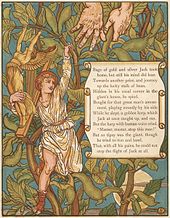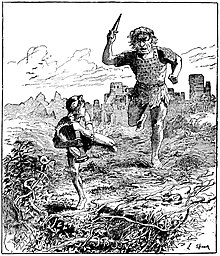| Jack and the Beanstalk | |
|---|---|
 Illustration by Arthur Rackham, 1918, in English Fairy Tales by Flora Annie Steel | |
| Folk tale | |
| Name | Jack and the Beanstalk |
| Also known as | Jack and the Giant man |
| Aarne–Thompson grouping | AT 328 ("The Treasures of the Giant") |
| Country | United Kingdom |
| Published in | Benjamin Tabart, The History of Jack and the Bean-Stalk (1807) Joseph Jacobs, English Fairy Tales (1890) |
| Related | "Jack the Giant Killer" |
"Jack and the Beanstalk" is an English fairy tale. It appeared as "The Story of Jack Spriggins and the Enchanted Bean" in 1734[1] and as Benjamin Tabart's moralized "The History of Jack and the Bean-Stalk" in 1807.[2] Henry Cole, publishing under pen name Felix Summerly, popularized the tale in The Home Treasury (1845),[3] and Joseph Jacobs rewrote it in English Fairy Tales (1890).[4] Jacobs' version is most commonly reprinted today, and is believed to be closer to the oral versions than Tabart's because it lacks the moralizing.[5]
"Jack and the Beanstalk" is the best known of the "Jack tales", a series of stories featuring the archetypal English hero and stock character Jack.[6]
According to researchers at Durham University and Universidade Nova de Lisboa, the story originated more than five millennia ago, based on a widespread archaic story form which is now classified by folklorists as ATU 328 The Boy Who Stole Ogre's Treasure.[7]

Jack, a poor country boy, trades the family cow for a handful of magic beans, which grow into a massive, towering beanstalk reaching up into the clouds. Jack climbs the beanstalk and finds himself in the castle of an unfriendly giant. Jack went inside the house and found the giant’s wife in the kitchen. Jack said, “Could you please give me something to eat? I am so hungry!”. The kind wife gave him bread and some milk. While he was eating, the giant came home. The giant senses Jack's presence and cries,
Fee-fi-fo-fum!
The giant was very big and looked very fearsome. Jack was terrified and went and hid inside. The giant cried, “Fee-fi-fo-fum, I smell the blood of an Englishman. Be he alive, or be he dead, I'll grind his bones to make my bread!” The wife said, “There is no boy in here!” So, the giant ate his food and then went to his room. He took out his sacks of gold coins, counted them and kept them aside. Then he went to sleep. In the night, Jack crept out of his hiding place, took one sack of gold coins and climbed down the beanstalk. At home, he gave the coins to his mother. His mother was very happy and they lived well for sometime.
Jack climbed the beanstalk and went to the giant’s house again. Once again, Jack asked the giant’s wife for food, but while he was eating the giant returned. Jack leapt up in fright and went and hid under the bed. The giant cried, “Fee-fi-fo-fum, I smell the blood of an Englishman. Be he alive, or be he dead, I'll grind his bones to make my bread!” The wife said, “There is no boy in here!” The giant ate his food and went to his room. There, he took out a hen. He shouted, “Lay!” and the hen laid a golden egg. When the giant fell asleep, Jack took the hen and climbed down the beanstalk. Jack’s mother was very happy with him.
After some days, Jack once again climbed the beanstalk and went to the giant’s castle. For the third time, Jack met the giant’s wife and asked for some food. Once again, the giant’s wife gave him bread and milk. But while Jack was eating, the giant came home. “Fee-fi-fo-fum, I smell the blood of an Englishman. Be he alive, or be he dead, I'll grind his bones to make my bread!” cried the giant. “Don't be silly! There is no boy in here!” said his wife.
The giant had a magical harp that could play beautiful songs. While the giant slept, Jack took the harp and was about to leave. Suddenly, the magic harp cried, “Help master! A boy is stealing me!” The giant woke up and saw Jack with the harp. Furious, he ran after Jack. But Jack was too fast for him. He ran down the beanstalk and reached home. The giant followed him down. Jack quickly ran inside his house and fetched an axe. He began to chop the beanstalk. The giant fell and died.
Jack and his mother were now very rich and they lived happily ever after.
Be he alive, or be he dead,
I'll grind his bones to make my bread.[8]
Outwitting the giant, Jack is able to retrieve many goods from the giant, including a bag of gold, an enchanted goose that lays golden eggs and a magic golden harp that plays and sings by itself. Jack then escapes by chopping down the beanstalk. The giant, who is pursuing him, falls to his death, and Jack and his family prosper.

"The Story of Jack Spriggins and the Enchanted Bean" was published in London by J. Roberts in the 1734 second edition of Round About Our Coal-Fire.[1] In 1807, English writer Benjamin Tabart published The History of Jack and the Bean Stalk, possibly actually edited by William and/or Mary Jane Godwin.[9]
The story is older than these accounts. According to researchers at Durham University and the Universidade Nova de Lisboa, the tale type (AT 328, The Boy Steals Ogre's Treasure) to which the Jack story belongs may have had a Proto-Indo-European language (PIE) origin (the same tale also has Proto-Indo-Iranian variants),[10] and so some think that the story would have originated millennia ago (4500 BC to 2500 BC).[7]
In some versions of the tale, the giant is unnamed, but many plays based on it name him Blunderbore (one giant of that name appears in the 18th-century tale "Jack the Giant Killer"). In "The Story of Jack Spriggins" the giant is named Gogmagog.[11]
The giant's catchphrase "Fee-fi-fo-fum! I smell the blood of an Englishman" appears in William Shakespeare's King Lear (c. 1606) in the form "Fie, foh, and fum, I smell the blood of a British man" (Act 3, Scene 4),[12] and something similar also appears in "Jack the Giant Killer".
"Jack and the Beanstalk" is an Aarne-Thompson tale-type 328, The Treasures of the Giant, which includes the Italian "Thirteenth" and the French "How the Dragon Was Tricked" tales. Christine Goldberg argues that the Aarne-Thompson system is inadequate for the tale because the others do not include the beanstalk, which has analogies in other types[13][14]
The Brothers Grimm drew an analogy between this tale and a German fairy tale, "The Devil With the Three Golden Hairs". The devil's mother or grandmother acts much like the giant's wife, a female figure protecting the child from the evil male figure.[15]

The original story portrays a "hero" gaining the sympathy of a man's wife, hiding in his house, robbing him, and finally killing him. In Tabart's moralized version, a fairy woman explains to Jack that the giant had robbed and murdered his father justifying Jack's actions as retribution[16] (Andrew Lang follows this version in the Red Fairy Book of 1890).
Jacobs gave no justification because there was none in the version he had heard as a child and maintained that children know that robbery and murder are wrong without being told in a fairy tale, but did give a subtle retributive tone to it by making reference to the giant's previous meals of stolen oxen and young children.[17]
Many modern interpretations have followed Tabart and made the giant a villain, terrorizing smaller folk and stealing from them, so that Jack becomes a legitimate protagonist. For example, the 1952 film starring Abbott and Costello the giant is blamed for poverty at the foot of the beanstalk, as he has been stealing food and wealth and the hen that lays golden eggs originally belonged to Jack's family. In other versions, it is implied that the giant had stolen both the hen and the harp from Jack's father. Brian Henson's 2001 TV miniseries Jack and the Beanstalk: The Real Story not only abandons Tabart's additions but vilifies Jack, reflecting Jim Henson's disgust at Jack's unscrupulous actions.[18]

